When it comes to refreshing and delicious ways to cool down, Icee is a popular choice. In this guide, we will dive into the fascinating world of icee nutrition facts and explore how this icy treat can fit into your healthy lifestyle. Whether you enjoy it on its own or use it to enhance your favorite beverages, icee offers a unique and satisfying way to beat the heat.
- Icee is primarily composed of carbohydrates, with a high sugar content that should be consumed in moderation.
- Icee is virtually fat-free and contains minimal amounts of protein.
- Icee does not provide significant amounts of vitamins or minerals, so it’s important to obtain these nutrients from other sources.
- Icee can contribute to your daily fluid intake and help keep you hydrated, but it should not replace water as the primary source of hydration.
- Practice portion control when consuming icee to manage sugar intake and prevent excessive calorie consumption.
- Icee does not contain common allergens such as milk, eggs, nuts, or wheat, but always check the specific ingredients if you have allergies or dietary restrictions.
Now, let’s delve into the details and uncover the nutritional value of icee, its calorie content, sugar content, and more. Get ready to discover the fascinating world of icee nutrition facts!
Understanding Icee Nutrition Composition
Before we get into the specifics of icee nutrition facts, it’s important to understand its composition and how it can contribute to your overall health and well-being. Icee, often enjoyed in the form of frozen beverages like Icee, is primarily made up of water. However, it also contains other components that can impact its nutritional value.
An Icee typically has a standard serving size of 8 ounces, but it’s essential to note that the calorie content can vary depending on the flavor and size. On average, an 8-ounce serving of Icee ranges from around 60 to 120 calories. If you’re watching your calorie intake, it’s important to be mindful of the flavor and portion size you choose.
| Nutrient | Content in Icee (8 oz serving) |
|---|---|
| Sugar | 15-30 grams |
| Fat | Minimal |
| Protein | Minimal |
| Sodium | 20-50 milligrams |
| Vitamins & Minerals | Not significant |
Icee is primarily composed of carbohydrates, with sugar being the main source. The sugar content can range from 15 to 30 grams per serving. It’s important to be aware of this sugar content, as excessive consumption of sugary beverages can have negative effects on your health.
On the positive side, Icee is virtually fat-free and contains minimal amounts of protein. This makes it a lighter option compared to other frozen treats that may be higher in fats and proteins.
Icee also contains some sodium, with an average 8-ounce serving containing around 20 to 50 milligrams. While this may not be a significant amount, individuals on a low-sodium diet should consider this when consuming Icee.
It’s important to note that Icee is not a significant source of vitamins or minerals. As a frozen beverage with high sugar content, it does not provide substantial amounts of essential nutrients. To ensure you’re getting the necessary vitamins and minerals, it’s crucial to maintain a balanced diet that includes a variety of fruits, vegetables, and whole foods.
Icee, with its vibrant and enticing colors, is often achieved through the use of artificial dyes and flavors. While visually appealing, it’s important to keep in mind that Icee is a high-sugar beverage. Practicing portion control is essential to manage your sugar intake and prevent excessive calorie consumption.
While Icee can be a refreshing treat and contribute to your daily fluid intake, it should not replace water as the primary source of hydration. Remember to drink plenty of water, especially in hot weather or after physical activity, to stay properly hydrated.
It’s worth noting that Icee does not contain common allergens such as milk, eggs, nuts, or wheat. However, if you have allergies or dietary restrictions, it’s always important to check the specific ingredients and potential cross-contamination risks before consuming Icee or any other frozen beverage.
Calorie Content of Icee
The calorie content of icee can vary depending on factors such as serving size and flavor, making it important to be mindful of your intake. While icee itself is a calorie-free substance, it is often consumed in the form of flavored icee products, such as sorbets or icee creams, which can contain varying amounts of calories. For example, a standard serving size of vanilla icee cream can range from around 140 to 250 calories, while a fruit sorbet may contain anywhere between 90 to 150 calories per serving.
It’s important to note that the calorie content of icee products can also be influenced by the ingredients used and the production methods. Some varieties may contain higher amounts of added sugars, fats, or preservatives, which can contribute to overall calorie content. It’s always a good idea to check the nutrition label or consult the manufacturer’s information for accurate calorie information.
| Flavor | Serving Size | Calories |
|---|---|---|
| Vanilla Ice Cream | 1 scoop (1/2 cup) | 140-250 |
| Chocolate Ice Cream | 1 scoop (1/2 cup) | 150-280 |
| Strawberry Sorbet | 1 scoop (1/2 cup) | 90-150 |
| Mango Sorbet | 1 scoop (1/2 cup) | 100-160 |
Ultimately, the calorie content of icee products should be considered in the context of your overall diet and health goals. While indulging in a frozen treat every now and then can be a delightful experience, it’s important to maintain a balanced and varied diet that includes a wide range of nutrient-dense foods to meet your nutritional needs.
Sugar Content in Icee
Sugar is a significant component of icee, and understanding its presence can help you make informed choices about your consumption. When it comes to icee nutrition facts, it’s essential to be aware of the sugar content, as excessive sugar intake can have negative effects on your health.
Icee, a popular frozen beverage, contains varying amounts of sugar depending on the flavor and serving size. A standard 8-ounce serving of Icee typically contains around 15 to 30 grams of sugar. This high sugar content is what gives Icee its sweet taste and vibrant colors. However, it’s important to note that consuming too much sugar can contribute to weight gain, tooth decay, and an increased risk of chronic diseases such as diabetes and heart disease.
To put the sugar content of Icee into perspective, consider that the American Heart Association recommends limiting daily added sugar intake to no more than 25 grams for women and 36 grams for men. Drinking a full-sized 20-ounce Icee, for example, could easily exceed these recommendations in just one serving. Therefore, it’s important to enjoy Icee in moderation and be mindful of your overall sugar intake from other sources as well.
| Icee Flavor | Serving Size | Sugar Content |
|---|---|---|
| Cherry | 8 oz | 15-30g |
| Blue Raspberry | 8 oz | 18-30g |
| Strawberry | 8 oz | 20-32g |
| Watermelon | 8 oz | 22-32g |
Remember, while indulging in an Icee can be a fun treat, it’s essential to be mindful of your sugar intake to maintain a balanced and healthy diet. Opting for smaller serving sizes or sharing a larger one can help manage your sugar consumption while still enjoying the refreshing flavors of Icee.
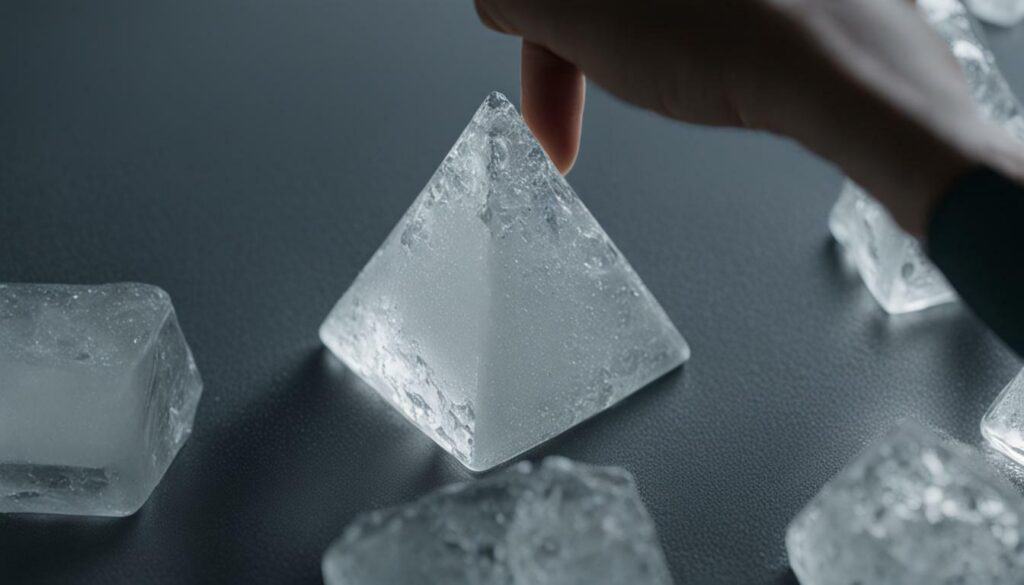
Ice is virtually fat-free and contains minimal amounts of protein, making it a low-calorie option for cooling down. With its refreshing qualities, ice is a popular choice to beat the heat and satisfy cravings. Whether enjoyed on its own or as an ingredient in various chilled treats, it offers a delightful way to cool off during hot summer days.
When it comes to fat content, ice has negligible amounts, which makes it an ideal choice for those watching their calorie intake. This frozen treat is primarily composed of water, resulting in a low-calorie option. So, indulge in a frosty ice cube or savor the crispness of shaved ice without the worry of added fats.
Similarly, ice contains minimal protein content. While protein is an essential macronutrient, ice is not a significant source. Instead, it provides hydration and a refreshing experience without contributing substantial protein to your diet. It’s important to incorporate other food sources, such as lean meats, dairy, legumes, and nuts, to meet your protein requirements.
| Nutrient | Content in Ice (per 8-ounce serving) |
|---|---|
| Calories | Approximately 0-5 calories |
| Fat | Negligible |
| Protein | Minimal |
“Icee is a guilt-free option to cool down and enjoy a tasty treat without worrying about excess fat or protein intake.”
So, the next time you crave something cool and refreshing, reach for icee. It provides a guilt-free option to cool down and enjoy a tasty treat without worrying about excess fat or protein intake. Share a shaved icee dessert with friends or savor an ice cube in a refreshing beverage. Remember to consume ice in moderation, maintaining a well-balanced diet that includes other nutrient-dense foods.
Sodium Content in Ice
While ice is generally low in sodium, it’s important to be aware of the specific sodium content based on the flavor and size you choose. Some flavored ice options may contain slightly higher sodium levels due to added ingredients or flavorings. For example, citrus or salted caramel flavors may have a slightly higher sodium content compared to traditional ice flavors like watermelon or strawberry.
According to the research, an 8-ounce serving of ice typically contains around 20 to 50 milligrams of sodium. It’s important to note that these values may vary depending on the brand and specific recipe. If you’re following a low-sodium diet or have specific sodium restrictions, it’s advisable to check the nutrition label or contact the manufacturer for more information about the sodium content of the ice flavors you’re considering.
| Ice Flavor | Sodium Content per Serving (8 ounces) |
|---|---|
| Watermelon | 20 mg |
| Strawberry | 25 mg |
| Citrus | 35 mg |
| Salted Caramel | 50 mg |
It’s worth noting that even with slightly higher sodium levels in flavored ice, the overall sodium content remains relatively low compared to other food and beverage options. However, it’s always important to monitor your sodium intake, especially if you have specific health concerns or are following a restricted diet.
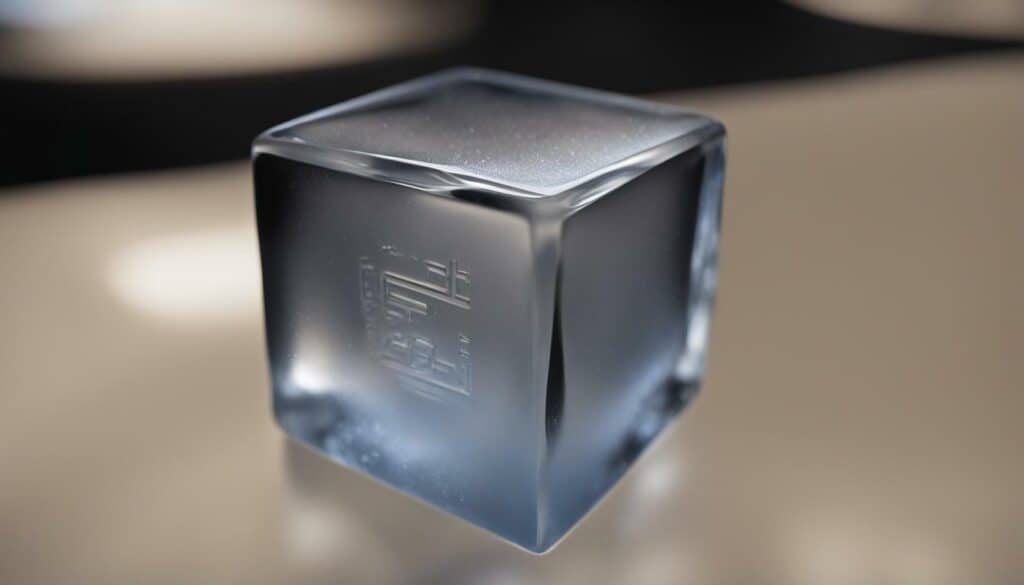
In conclusion, while ice is generally low in sodium, it’s advisable to be mindful of the specific sodium content based on the flavor and size you choose. Moderation is key, and incorporating a variety of low-sodium foods into your diet is essential for overall health and wellbeing.
Lack of Essential Nutrient in Icee
While icee can be a refreshing treat, it’s essential to recognize that it does not provide substantial amounts of essential nutrients typically found in a well-rounded diet. Icee is primarily composed of water, with minimal nutritional value beyond its hydrating properties. It does not contain significant amounts of vitamins, minerals, or other essential nutrients.
Icee, by itself, is not intended to serve as a primary source of nourishment. Instead, it is a cool and refreshing option that can be enjoyed in moderation as part of a balanced diet. To meet your nutritional needs, it is important to include a variety of fruits, vegetables, whole grains, lean proteins, and other nutrient-rich foods in your daily meals.
While icee may not contribute to your overall nutrient intake, it can still be a delightful way to quench your thirst and provide temporary relief from hot weather or physical activity. Remember to practice portion control and be mindful of your overall sugar and calorie consumption when enjoying icee. Opting for smaller serving sizes or sharing with others can help you manage your intake and maintain a balanced diet.
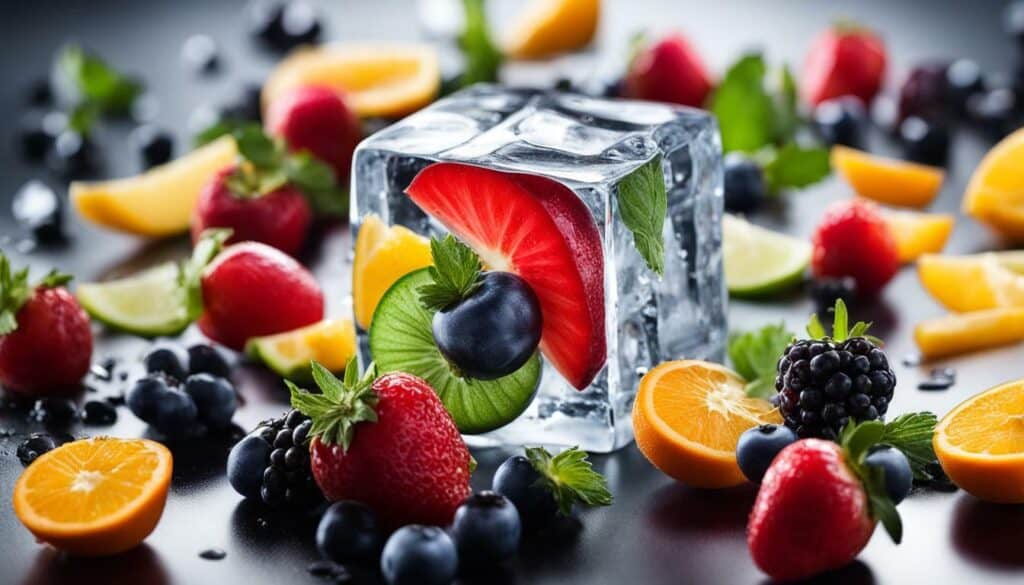
| Nutrient | Amount in Ice |
|---|---|
| Calories | Varies based on serving size and flavor, ranging from around 60 to 120 calories per serving. |
| Sugar | Varies based on serving size and flavor, ranging from approximately 15 to 30 grams per serving. |
| Fat | Minimal, virtually fat-free. |
| Protein | Minimal, contains only small amounts of protein. |
| Sodium | Average of 20 to 50 milligrams per 8-ounce serving, may vary based on flavor and size. |
| Vitamins and Minerals | Not a significant source of vitamins or minerals. |
Keep in mind that while icee can be a refreshing and enjoyable treat, it’s important to obtain essential nutrients from a well-rounded diet that includes a variety of nutritious foods. Icee should not be relied upon as a primary source of nourishment but instead enjoyed in moderation as a delightful cool down option.
Hydration and Ice Consumption
Icee can be an excellent way to cool down while also helping you stay hydrated, particularly during hot weather or after physical activity. When the temperatures rise, our bodies naturally sweat to regulate temperature, which can lead to fluid loss and potential dehydration. By consuming icee, you can replenish your body’s fluid levels and prevent dehydration.
One of the benefits of consuming icee is that it can provide a refreshing and satisfying sensation, especially on a hot day. Chewing on ice cubes or enjoying a cold frozen treat can help lower your body temperature and provide temporary relief from the heat.
In addition to hydration, ice can also be a source of comfort and enjoyment. Many people find the act of crunching on ice cubes to be a stress-relieving activity or a way to satisfy cravings for something cold and flavorful. Be careful, though, you do not want to damage your teeth.
Table: Hydration Benefits of Ice Consumption
| Hydration Benefits | Explanation |
|---|---|
| Temperature Regulation | Ice consumption can help lower body temperature and provide relief on hot days. |
| Replenishment of Fluids | Chewing on ice or consuming ice-based treats can help replenish fluids lost through sweating. |
| Refreshing Sensation | The cold and satisfying sensation of ice can provide comfort and enjoyment. |
While ice can contribute to your daily fluid intake, it should not replace water as the primary source of hydration. Water remains essential for maintaining overall health and well-being. It is important to consume a balanced amount of fluids, including water, along with other hydrating sources like fruits and vegetables.
Remember: Stay cool and hydrated this summer by incorporating ice into your diet. Beat the heat and enjoy the refreshing benefits that ice can provide, but always remember to drink water regularly to maintain optimal hydration.

Practicing Portion Control with Icee
While icee can be a fun and enjoyable treat, practicing portion control is vital to manage your sugar intake and prevent excessive calorie consumption. Opting for smaller serving sizes or sharing a larger one can help you indulge in this frozen delight without overindulging in sugar and calories.
Icee is primarily composed of carbohydrates, with sugar being the main source. The sugar content in icee can range from 15 to 30 grams per serving, depending on the flavor and size. By being mindful of portion sizes, you can strike a balance between satisfying your sweet tooth and maintaining a healthy diet.
Portion control not only helps you manage your calorie and sugar intake but also ensures that you maintain overall balance and variety in your diet. While icee can be a delightful treat, it should not replace nutrient-rich whole foods that provide essential vitamins and minerals. By enjoying icee in moderation and incorporating it into a well-rounded diet, you can savor its refreshing taste while also nourishing your body.
| Portion Sizes | Sugar Content (grams) | Calories |
|---|---|---|
| Small | 15 | 60-80 |
| Medium | 20 | 80-100 |
| Large | 30 | 100-120 |
Remember, portion control is not about depriving yourself but rather about finding a balance that allows you to enjoy your favorite treats while also maintaining a healthy lifestyle. So, next time you reach for a serving of ice, be mindful of the size and make choices that align with your health goals.
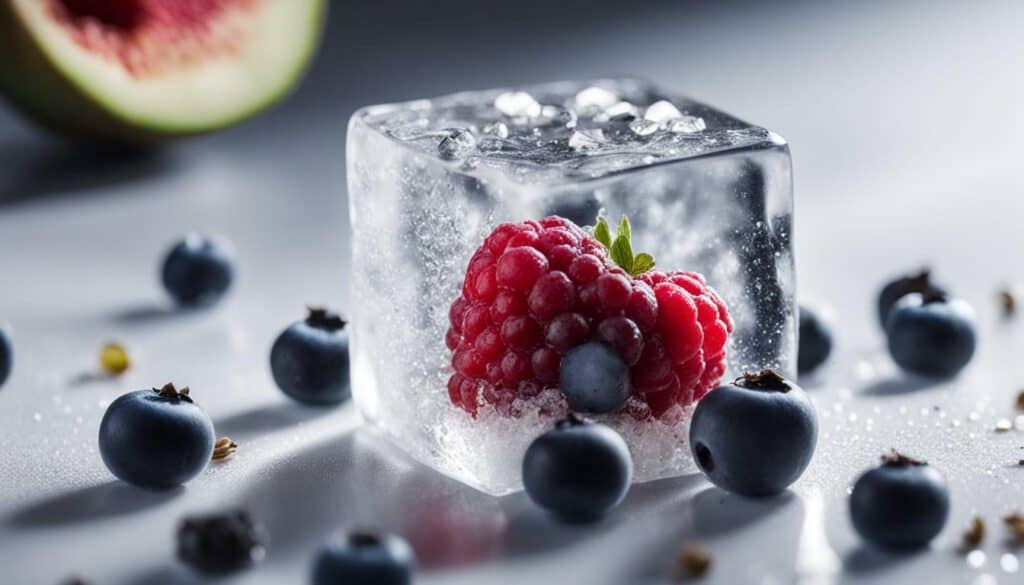
Conclusion
In conclusion, exploring the icee nutrition facts can help you make informed choices about incorporating this cool down option into your healthy lifestyle. Icee is a popular frozen beverage known for its refreshing and sweet flavors. It is important to understand its nutritional composition and its potential impact on your diet.
Icee comes in various sizes, but the standard serving size is typically 8 ounces. The calorie content of an Icee can vary depending on the flavor and size, ranging from around 60 to 120 calories per serving. It is important to note that Icee is a high-sugar beverage and should be consumed in moderation.
Icee is primarily composed of carbohydrates, with sugar being the main source. The sugar content in an Icee can range from 15 to 30 grams per serving. It is important to practice portion control when consuming Icee to manage your sugar intake and prevent excessive calorie consumption.
While Icee can be a fun and enjoyable treat, it is essential to recognize that it has limited nutritional value beyond providing a source of carbohydrates and calories. It does not contain significant amounts of fat, protein, vitamins, or minerals. Therefore, it is important to obtain these essential nutrients from a balanced diet that includes a variety of fruits, vegetables, and whole foods.
Icee can contribute to your daily fluid intake and help keep you hydrated, especially in hot weather or after physical activity. However, it should not replace water as the primary source of hydration. It is also important to be mindful of the artificial dyes and flavors used to achieve the vibrant colors in Icee.
By understanding the nutritional facts of Icee and practicing moderation, you can enjoy this cool down option as part of a balanced and healthy lifestyle.
FAQ
Q: What is the calorie content of Icee?
A: The calorie content of an Icee can vary depending on the flavor and size, ranging from around 60 to 120 calories per serving.
Q: How much sugar does an Icee contain?
A: The sugar content in an Icee can range from 15 to 30 grams per serving.
Q: Is Icee a significant source of fat or protein?
A: Icee is virtually fat-free and contains minimal amounts of protein.
Q: How much sodium does an Icee have?
A: On average, an 8-ounce serving of Icee contains around 20 to 50 milligrams of sodium.
Q: Does Icee provide any vitamins or minerals?
A: Icee is not a significant source of vitamins or minerals.
Q: Can Icee contribute to hydration?
A: Icee can contribute to your daily fluid intake and help keep you hydrated, especially in hot weather or after physical activity.
Q: Does Icee contain artificial dyes and flavors?
A: Yes, Icee’s vibrant and enticing colors are often achieved through the use of artificial dyes and flavors.
Q: How can I practice portion control with Icee?
A: Opting for smaller serving sizes or sharing a larger one can help manage your sugar intake and prevent excessive calorie consumption.
Q: Does Icee contain common allergens?
A: Icee does not contain common allergens such as milk, eggs, nuts, or wheat. However, it is always important to check the specific ingredients and potential cross-contamination risks if you have allergies or dietary restrictions.
What Are the Calorie Count and Nutritional Value of Icee Compared to Frozen Yogurt?
When comparing the nutritional aspects of Icee and frozen yogurt, the frozen yogurt vanilla calories revealed a notable difference. While the exact count might vary depending on brands and serving sizes, frozen yogurt generally contains fewer calories than Icee. Moreover, frozen yogurt usually offers additional nutritional benefits such as protein and calcium, making it a healthier option for those counting calories and seeking a more balanced treat.

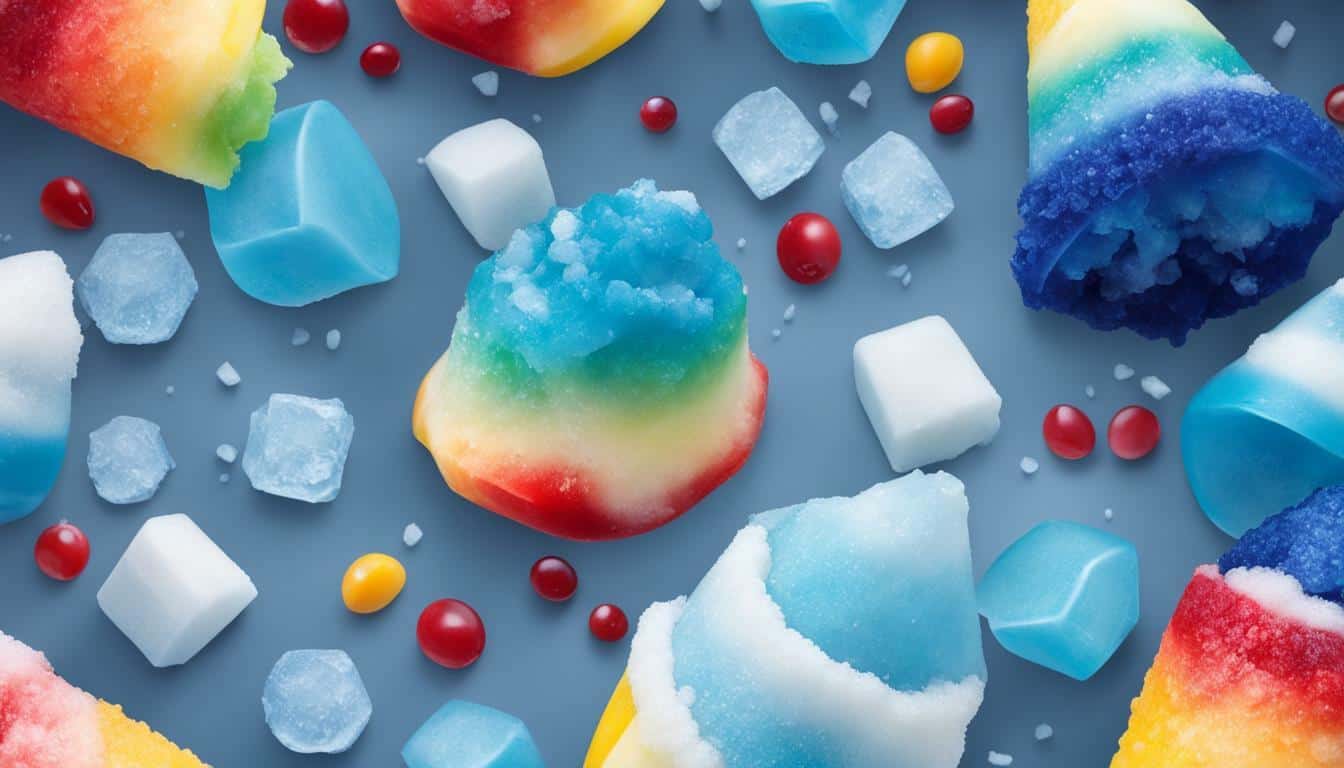



Leave a Reply